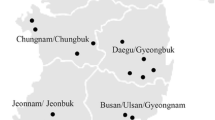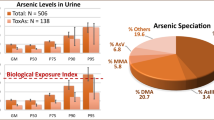Abstract
Gold has been mined at San Antonio-El Triunfo, (Baja California Sur, Mexico) since the 18th century. This area has approximately 5,700 inhabitants living in the San Juan de Los Planes and El Carrizal hydrographic basins, close to more than 100 abandoned mining sites containing tailings contaminated with potentially toxic elements such as arsenic. To evaluate the arsenic exposure of humans living in the surrounding areas, urinary arsenic species, such as inorganic arsenic (iAs) and the metabolites mono-methylated (MMA) and di-methylated arsenic acids (DMA), were evaluated in 275 residents (18–84 years of age). Arsenic species in urine were analyzed by hydride generation-cryotrapping-atomic absorption spectrometry, which excludes the non-toxic forms of arsenic such as those found in seafood. Urinary samples contained a total arsenic concentration (sum of arsenical species) which ranged from 1.3 to 398.7 ng mL−1, indicating 33 % of the inhabitants exceeded the biological exposition index (BEI = 35 ng mL−1), the permissible limit for occupational exposure. The mean relative urinary arsenic species were 9, 11 and 80 % for iAs, MMA and DMA, respectively, in the Los Planes basin, and 17, 10 and 73 %, respectively, in the El Carrizal basin. These data indicated that environmental intervention is required to address potential health issues in this area.




Similar content being viewed by others
References
ACGIH, American Conference of Governmental Industrial Hygienists. (2010). Threshold limit values (TLVs) for chemical substances and physical agents and biological exposure indices (BEIs) 210 p.
ATSDR, Agency for Toxic Substances and Disease Registry. (2007). Toxicological profile for arsenic. Atlanta, GA: U.S Department of Health and Human Services, Public Health Service.
Basu, A., Mitra, S., Chung, J., Mazumder, D. N. G., Ghosh, N., Kalman, D., et al. (2011). Creatinine, diet, micronutrients, and arsenic methylation in West Bengal, India. Environmental Health Perspectives, 119, 1308–1313.
Bodénan, F., Baranger, P., Piantone, P., Lassin, A., Azaroual, M., Gaucher, E., et al. (2004). Arsenic behaviour in gold-ore mill tailings, Massif Central, France: Hydro geochemical study and investigation of in situ redox signatures. Applied Geochemistry, 19, 1785–1800.
Carrillo, A. (1996). Enviromental geochemistry of the San Antonio—El Triunfo mining area, southernmost Baja California Peninsula Mexico. PhD Thesis in Geology, Laramie Wyoming, 130 p.
Celik, I., Gallicchio, L., Boyd, K., Lam, T. K., Matanoski, G., Tao, X., et al. (2008). Arsenic in drinking water and lung cancer: A systematic review. Environmental Research, 108, 48–55.
Chen, Y., Ahsan, H., Slavkovich, V., Peltier, G. L., Gluskin, R. T., Parvez, F., et al. (2010). No association between arsenic exposure from drinking water and diabetes mellitus: A cross-sectional study in Bangladesh. Environmental Health Perspectives, 118, 1299–1305.
Chen, C. I., Chiou, H. Y., Chiang, M. H., Lin, L. J., & Tai, T. Y. (1996). Dose-response relationship between ischemic heart disease and long term arsenic exposure. Arteriosclerosis, Thrombosis, and Vascular Biology, 16, 504–510.
Cho, Y. M., Seo, S. C., Choi, S. H., Lee, S. K., Kim, K. H., Kim, H. J., et al. (2013). Association of arsenic levels in soils and water with urinary arsenic concentrations of residents in vicinity of closed metal mines. International Journal of Hygiene and Environmental Health, 216, 255–262.
Chun-Yu, R., Hung, K.-H., Chen, C.-J., & Froines, J. R. (2000). Arsenic methylation capacity and skin cancer. Cancer Epidemiology, Biomarkers and Prevention, 9, 1259–1262.
CNA. (2003). Comisión Nacional del Agua. Gerencia estatal en Baja California Sur. Estudio de caracterización de la intrusión salina en el acuífero de los Planes BCS. 525 p.
Coronado-González, J. A., Del Razo, L. M., García-Vargas, G., Sanmiguel-Salazar, F., & de la Escobedo Peña, J. (2007). Inorganic arsenic exposure and type 2 diabetes mellitus in Mexico. Environmental Research, 104, 383–389.
Crecelius, E. A. (1977). Changes in the chemical speciation of arsenic following ingestion by man. Environmental Health Perspectives, 19, 147–150.
Currier, J. M., Saunders, J., Ding, L., Bodnar, W., Cable, P., Matoušek, T., et al. (2013). Comparative oxidation state specific analysis of arsenic by high-performance liquid chromatography-inductively coupled plasma-mass spectrometry and hydride generation-cryotrapping-atomic absorption spectrometry. Journal Analytical Atomic Spectrometry, 28, 843–852.
Del Razo, L. M., García-Vargas, G., Valenzuela, O. L., Hernández-Castellanos, E., Sánchez-Peña, L. C., Currier, J. M., et al. (2011). Exposure to arsenic in drinking water is associated with increased prevalence of diabetes: A cross-sectional study in the Zimapan and Lagunera regions in Mexico. Environmental Health, 10(73), 1–11.
Del Razo, L. M., García-Vargas, G. G., Vargas, H., Albores, A., Gonsebatt, M. E., Montero, R., et al. (1997). Altered profile of urinary arsenic metabolites in adults with chronic arsenicism: A pilot study. Archives of Toxicology, 71(4), 211–217.
Heitland, P., & Köster, H. D. (2009). Comparison of different medical cases in urinary arsenic speciation by fast HPLC-ICP-MS. International Journal of Hygiene and Environmental Health, 212, 432–438.
Herbel, M. J., Switzer Blum, J., Hoeft, S. E., Cohen, S. M., Arnold, L. L., Lisak, J., et al. (2002). Dissimilatory arsenate reductase activity and arsenate –respiring bacteria in bovine rumen fluid, hamster feces and the termite hindgut. FEMS Microbiology Ecology, 41, 59–67.
Hernández-Zavala, A., Matoušek, T., Drobná, Z., Adair, B. M., Dĕdina, J., Thomas, D. J., et al. (2008). Speciation of arsenic in biological matrices by automated hydride generation–cryotrapping–atomic absorption spectrometry with multiple microflame quartz tubeatomizer (multiatomizer). Journal Analytical Atomic Spectrometry, 23, 342–351.
Hughes, M. F., Beck, B. D., Chen, Y., Lewis, A. S., & Thomas, D. J. (2011). Arsenic exposure and toxicology: A historical perspective. Toxicology Science, 123, 305–332.
IARC (International Agency for Research on Cancer). (2004). Some drinking-water disinfectants and contaminants, including arsenic. In IARC Monographs on the evaluation of carcinogenic risks to humans (Vol. 84, pp. 1–19). World Health Organization.
INEGI (Instituto Nacional de Estadística Geografía e Informática). (2010). Censo de población y vivienda 2010. Consulta interactiva de datos. http://cuentame.inegi.org.mx/poblacion/habitantes.aspx.
Krysiak, A., & Karczewska, A. (2007). Arsenic extractability in soils in the areas of former arsenic mining and smelting, SW Poland. Science of the Total Environment, 379, 190–200.
Lim, H. S., Lee, J.-S., Chon, H.-T., & Sager, M. (2008). Heavy metal contamination and health risk assessment in the vicinity of the abandoned songcheon Au–Ag mine in Korea. Journal of Geochemical Exploration, 96, 223–230.
Marmolejo-Rodriguez, A. J., Sánchez-Martínez, M. A., Romero-Guadarrama, J. A., Sánchez-Gonzalez, A., & Magallanes-Ordoñez, V. R. (2011). Migration of As, Hg, Pb, and Zn in arroyo sediments from a semiarid coastal system influenced by the abandoned gold mining district at El Triunfo, Baja California Sur, México. Journal of Environmental Monitoring, 13, 2182–2189.
Mazumder, G. (2008). Chronic arsenic toxicity and human health. Indian Journal of Medical Research, 128, 436–447.
Nava-Sánchez, E. H. (1992). Sedimentología de la Cuenca San Juan de Los Planes, Baja California Sur, México. Masters Thesis (CICIMAR-IPN) 166 pp (In Spanish).
Niparaja-Guardianes del Agua (2011). Concentración de Arsénico en agua de pozos de la cuenca hidrológica de San Juan de Los Planes. Datos del Servicio Geológico Mexicano, orden 10120. Date: 11-03-2010. (In Spanish).
NOM-127-SSA. (1994). Norma Oficial Mexicana. Salud ambiental, agua para uso y consumo humano. Límites permisibles de calidad y tratamientos a que debe someterse el agua para su potabilización. Diario Oficial de la Federación. Mexico. (In Spanish).
NRC (National Research Council). (1999). Arsenic in drinking water. Washington, DC: National Academy Press.
Pellizzari, E. D., & Clayton, C. A. (2006). Assessing the measurement precision of various arsenic forms and arsenic exposure in the national human exposure assessment survey (NHEXAS). Environmental Health Perspectives, 140(2), 220–227.
Posada-Ayala, I.H. (2011). Geoquímica ambiental del Distrito Minero San Antonio, sedimentos de arroyos de la Cuenca de San Juan de los Planes y plataforma continental de Bahia La Ventana, BCS, Mexico. Masters Thesis (CICIMAR-IPN) 210 pp. (In Spanish).
Robles, G.S. (1985). Estudio geográfico del Estado de Baja California Sur. Dirección de Cultura Gobierno de BCS, México. In: E.H. Nava-Sánchez (eds) (1992). Sedimentología de la Cuenca San Juan de Los Planes, Baja California Sur, México. Master Thesis (CICIMAR-IPN), 178p (In Spanish).
Romero-Guadarrama, J.A. (2011). Geoquímica de As, Hg, Pb y Zn y mineralogía en sedimentos superficiales de la cuanca de drenaje del distrito minero El Triunfo, BCS., México. Masters Thesis (CICIMAR-IPN) 98 pp (In Spanish).
Sánchez-Martínez, M. A., Marmolejo-Rodríguez, A. J., Gómez-Millán, R., Sánchez-González, A., Magallanes-Ordóñez, V. R., Romero-Guadarrama, J. A., et al. (2013a). Sediment accumulation of Ag, Cu, and Ni through a semi-arid basin as a by-product of the El Triunfo gold mine, Baja California Sur México. Journal of Iberian Geology, 39(1), 97–110.
Sánchez-Martínez, M. A., Marmolejo-Rodríguez, A. J., Magallanes-Ordóñez, V. R., & Sánchez-González, A. (2013b). Vertical accumulation of potential toxic elements in a semiarid system that is influenced by an abandoned gold mine. Estuarine Coastal and Shelf Sciences, 130, 42–53.
Smith, A. H., Hopenhayn-Rich, C., & Bates, M. N. (1992). Cancer risk from arsenic in drinking water. Environmental Health Perspectives, 97, 259–267.
Soleo, L., Lovreglio, P., Iavicoli, S., Antelmi, A., Drago, I., Basso, A., et al. (2008). Significance of urinary arsenic speciation in assessment of seafood ingestion as the main source of organic and inorganic arsenic in a population resident near a coastal area. Chemosphere, 73, 291–299.
Steinmaus, C., Bates, M. N., Yuan, Y., Kalman, D., Atallah, R., Rey, O. A., et al. (2006). Arsenic methylation and bladder cancer risk in case–control studies in Argentina and the United States. Journal Occupational Environmental Medicine, 48(5), 478–488.
Valenzuela, O. L., Borja-Aburto, V. H., García Vargas, G., Cruz-González, M., Garcia-Montalvo, E., Calderon-Aranda, E., et al. (2005). Urinary trivalent methylated arsenic species in a population chronically exposed to inorganic arsenic. Enviromental Health Perspectives, 113(3), 250–254.
Volke-Sepulveda, T., Solorzano-Ochoa, G., Rosas-Domínguez, A., Izumikawa, C., Aguilar, G.E., Velazco-Trejo, J.A., & Flores-Martínez, S. (2003). Remediación de sitios contaminados por metales provenientes de jales mineros en los distritos de El Triunfo—San Antonio y Santa Rosalia, Baja California Sur. Informe Técnico. Dirección de Investigación en Residuos y proyectos regionales. Centro de Investigación y capacitación ambiental. Instituto Nacional de Ecología. Technical Report. 1–37 (In Spanish).
Watson, W. A., Litovitz, T. L., Rodger, S. G. C., Klein-Schwartz, W., Youniss, J., Rose, S. R., et al. (2003). 2002 Annual report of the American association of poison control center toxic exposure surveillance system. The American Journal of Emergency Medicine, 21, 353–421.
Wedepohl, K. H. (1995). The composition of the continental crust. Geochimica et Cosmochimica Acta, 59(7), 1217–1232.
WHO (World Health Organization) 2001. Arsenic in drinking water, http://www.who.int/inf-fs/en/fact210.html.
Acknowledgments
This study was supported by the Consejo Nacional de Ciencia y Tecnología—project No. 98710 (SIP 20101323 and SIP20131030). We gratefully thank the Health Chairman of La Paz County and the Health Center Directors of each town who organized talks to ask people to help in the study, and a special thanks to the participants that collaborated in this study.
Author information
Authors and Affiliations
Corresponding author
Rights and permissions
About this article
Cite this article
Colín-Torres, C.G., Murillo- Jiménez, J.M., Del Razo, L.M. et al. Urinary arsenic levels influenced by abandoned mine tailings in the Southernmost Baja California Peninsula, Mexico. Environ Geochem Health 36, 845–854 (2014). https://doi.org/10.1007/s10653-014-9603-x
Received:
Accepted:
Published:
Issue Date:
DOI: https://doi.org/10.1007/s10653-014-9603-x




